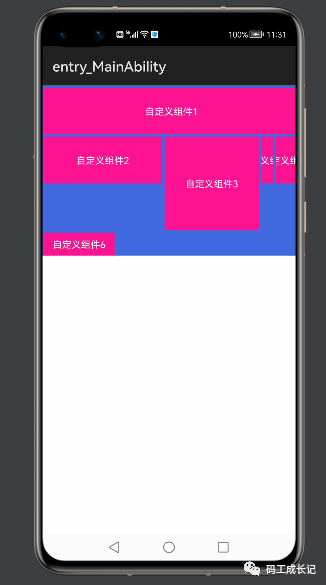大家好,我是你们的朋友 朋哥,今天聊聊自定义布局,自定义布局就是当前系统布局不满足时的布局方式。
上一篇原创文章?解读了?鸿蒙开发布局的 自适应盒子布局(AdaptiveBoxLayout),通过设置布局规则来调整布局,到目前,布局开发基本完成了。
有点激动接下来的组件,目录已经准备好,大家跟进步伐。
布局完成肯定要总结一下,其实布局是开发ui的关键,需要开发者做到,看到界面就能明白需要用上面布局做开发。
?
为了更好的理解布局的作用,今天来开发一下自定义布局。
简介:
来看看官方对自定义的说明。
HarmonyOS提供了一套复杂且强大的Java UI框架,其中ComponentContainer作为容器容纳Component或ComponentContainer对象,并对它们进行布局。
Java UI框架也提供了一部分Component和ComponentContainer的具体子类,即常用的组件(比如:Text、Button、Image等)和常用的布局(比如:DirectionalLayout、DependentLayout等)。如果现有的组件和布局无法满足设计需求,例如仿遥控器的圆盘按钮、可滑动的环形控制器等,可以通过自定义组件和自定义布局来实现。
自定义布局是由开发者定义的具有特定布局规则的容器类组件,通过扩展ComponentContainer或其子类实现,可以将各子组件摆放到指定的位置,也可响应用户的滑动、拖拽等事件。
总结起来就是:当Java UI框架提供的布局无法满足设计需求时,可以创建自定义布局,根据需求自定义布局规则。
相关接口
Component类相关接口
| 接口名称 | 作用 |
|---|
| setEstimateSizeListener | 设置测量组件的侦听器。 |
| onEstimateSize | 测量组件的大小以确定宽度和高度。 |
| setEstimatedSize | 将测量的宽度和高度设置给组件。 |
| EstimateSpec.getChildSizeWithMode | 基于指定的大小和模式为子组件创建度量规范。 |
| EstimateSpec.getSize | 从提供的度量规范中提取大小。 |
| EstimateSpec.getMode | 获取该组件的显示模式。 |
| arrange | 相对于容器组件设置组件的位置和大小。 |
ComponentContainer类相关接口
| 接口名称 | 作用 |
|---|
| setArrangeListener | 设置容器组件布局子组件的侦听器。 |
| onArrange | 通知容器组件在布局时设置子组件的位置和大小。 |
学习开发动手敲一下代码,才能理解的更深入。
?
1,创建项目
首先创建一个鸿蒙项目(Java版),关于创建项目 有新手不知道怎么创建的,可以查看第一篇文章??鸿蒙开发入门?。
2,创建自定义布局的类,并继承ComponentContainer
实现ComponentContainer.EstimateSizeListener接口,在onEstimateSize方法中进行测量。
代码如下:
package?com.example.customlayout;
import ohos.agp.components.Component;
import ohos.agp.components.ComponentContainer;
import ohos.app.Context;
import java.util.HashMap;
import java.util.Map;
public class CustomLayout extends ComponentContainer implements ComponentContainer.EstimateSizeListener
,ComponentContainer.ArrangeListener{
private int xx = 0;
private int yy = 0;
private int maxWidth = 0;
private int maxHeight = 0;
private int lastHeight = 0;
// 子组件索引与其布局数据的集合
private final Map<Integer, Layout> axis = new HashMap<>();
public CustomLayout(Context context) {
super(context);
setEstimateSizeListener(this);// 设置监听
setArrangeListener(this);// 设置子组件排列监听
}
private static class Layout {
int positionX = 0;
int positionY = 0;
int width = 0;
int height = 0;
}
private void invalidateValues() {
xx = 0;
yy = 0;
maxWidth = 0;
maxHeight = 0;
axis.clear();
}
// 实现ComponentContainer.EstimateSizeListener接口,在onEstimateSize方法中进行测量
@Override
public boolean onEstimateSize(int widthEstimatedConfig, int heightEstimatedConfig) {
// 通知子组件进行测量
measureChildren(widthEstimatedConfig, heightEstimatedConfig);
int width = Component.EstimateSpec.getSize(widthEstimatedConfig);
// 关联子组件的索引与其布局数据
for (int idx = 0; idx < getChildCount(); idx++) {
Component childView = getComponentAt(idx);
addChild(childView, idx, width);
}
setEstimatedSize(
Component.EstimateSpec.getChildSizeWithMode(maxWidth, widthEstimatedConfig, 0),
Component.EstimateSpec.getChildSizeWithMode(maxHeight, heightEstimatedConfig, 0));
return true;
}
private void measureChildren(int widthEstimatedConfig, int heightEstimatedConfig) {
for (int idx = 0; idx < getChildCount(); idx++) {
Component childView = getComponentAt(idx);
if (childView != null) {
measureChild(childView, widthEstimatedConfig, heightEstimatedConfig);
}
}
}
private void measureChild(Component child, int parentWidthMeasureSpec, int parentHeightMeasureSpec) {
ComponentContainer.LayoutConfig lc = child.getLayoutConfig();
int childWidthMeasureSpec = EstimateSpec.getChildSizeWithMode(
lc.width, parentWidthMeasureSpec, EstimateSpec.UNCONSTRAINT);
int childHeightMeasureSpec = EstimateSpec.getChildSizeWithMode(
lc.height, parentHeightMeasureSpec, EstimateSpec.UNCONSTRAINT);
child.estimateSize(childWidthMeasureSpec, childHeightMeasureSpec);
????}
// 测量时,需要确定每个子组件大小和位置的数据,并保存这些数据
private void addChild(Component component, int id, int layoutWidth) {
Layout layout = new Layout();
layout.positionX = xx + component.getMarginLeft();
layout.positionY = yy + component.getMarginTop();
layout.width = component.getEstimatedWidth();
layout.height = component.getEstimatedHeight();
if ((xx + layout.width) > layoutWidth) {
xx = 0;
yy += lastHeight;
lastHeight = 0;
layout.positionX = xx + component.getMarginLeft();
layout.positionY = yy + component.getMarginTop();
}
axis.put(id, layout);
lastHeight = Math.max(lastHeight, layout.height + component.getMarginBottom());
xx += layout.width + component.getMarginRight();
maxWidth = Math.max(maxWidth, layout.positionX + layout.width);
maxHeight = Math.max(maxHeight, layout.positionY + layout.height);
????}
// 实现ComponentContainer.ArrangeListener接口,在onArrange方法中排列子组件
@Override
public boolean onArrange(int left, int top, int width, int height) {
// 对各个子组件进行布局
for (int idx = 0; idx < getChildCount(); idx++) {
Component childView = getComponentAt(idx);
Layout layout = axis.get(idx);
if (layout != null) {
childView.arrange(layout.positionX, layout.positionY, layout.width, layout.height);
}
}
return true;
}
}
??????
说明:
1,实现ComponentContainer.EstimateSizeListener接口,在onEstimateSize方法中进行测量
2,注意事项:
容器类组件在自定义测量过程不仅要测量自身,也要递归的通知各子组件进行测量。
测量出的大小需通过setEstimatedSize设置给组件,并且必须返回true使测量值生效。
测量时,需要确定每个子组件大小和位置的数据,并保存这些数据
3,实现ComponentContainer.ArrangeListener接口,在onArrange方法中排列子组件
4,自定义布局功能就是实现组件的自适应显示,按照线性布局排列。
?
3,自定义布局的使用
package com.example.customlayout;
import ohos.aafwk.ability.Ability;
import ohos.aafwk.content.Intent;
import ohos.agp.colors.RgbColor;
import ohos.agp.components.Button;
import ohos.agp.components.Component;
import ohos.agp.components.DirectionalLayout;
import ohos.agp.components.element.ShapeElement;
import ohos.agp.utils.Color;
public class MainAbility extends Ability {
@Override
public void onStart(Intent intent) {
DirectionalLayout myLayout = new DirectionalLayout(getContext());
CustomLayout customLayout = new CustomLayout(this);// 自定义布局 设置线性布局,多个组件的宽度大于屏幕的宽度会自动换行显示
for (int idx = 0; idx < 6; idx++) {
customLayout.addComponent(getComponent(idx + 1));
}
????????// 自定义布局背景颜色
ShapeElement shapeElement = new ShapeElement();
shapeElement.setRgbColor(RgbColor.fromArgbInt(Color.getIntColor("#4169E1")));
customLayout.setBackground(shapeElement);
????????myLayout.addComponent(customLayout);?//自定义布局添加到布局DirectionalLayout中
????????super.setUIContent(myLayout);//?将布局添加到?根布局中显示
}
//创建动态子组件
private Component getComponent(int idx) {
Button button = new Button(getContext()); // 创建个按钮
????????//?设置按钮颜色
ShapeElement shapeElement = new ShapeElement();
shapeElement.setRgbColor(RgbColor.fromArgbInt(Color.getIntColor("#FF1493")));
button.setBackground(shapeElement);
button.setTextColor(Color.WHITE);// 按钮字体颜色
button.setTextSize(40); // 设置字体大小
????????//?设置每个按钮布局,包括大小和内容
DirectionalLayout.LayoutConfig layoutConfig = new DirectionalLayout.LayoutConfig(300, 100);
if (idx == 1) {
layoutConfig = new DirectionalLayout.LayoutConfig(1080, 200);
button.setText("自定义组件1");
} else if (idx == 2) {
layoutConfig = new DirectionalLayout.LayoutConfig(500, 200);
button.setText("自定义组件2");
} else if (idx == 3) {
layoutConfig = new DirectionalLayout.LayoutConfig(400, 400);
button.setText("自定义组件3");
} else if (idx == 4) {
layoutConfig = new DirectionalLayout.LayoutConfig(50, 200);
button.setText("自定义组件4");
} else if (idx == 5) {
layoutConfig = new DirectionalLayout.LayoutConfig(100, 200);
button.setText("自定义组件5");
} else {
button.setText("自定义组件6");
}
layoutConfig.setMargins(10, 10, 10, 10);
button.setLayoutConfig(layoutConfig);
return button;
}
}
1,在 MainAbility中实现自定义布局的调用,并且创建动态组件,显示组件的大小和样式。
自定义布局是因为当前布局不能满足需要或者为了统一布局?从新做的布局规则。
需要重写?ComponentContainer?实现需要的接口完成布局的设置。
运行效果图:
?

?
老规矩 代码不能少,要不然小伙伴该说我小气了。
代码连接:?https://gitee.com/codegrowth/haomony-develop.git
?
关注公众号【程序员漫话编程】,后台回复【鸿蒙】,即可获取上千鸿蒙开源组件~
原创不易,有用就关注一下。要是帮到了你 就给个三连吧,多谢支持。
?
觉得不错的小伙伴,记得帮我?点个赞和关注哟,笔芯笔芯~**
作者:码工
?
有问题请留言或者私信,可以 微信搜索:程序员漫话编程,关注公众号获得更多免费学习资料。
cs


